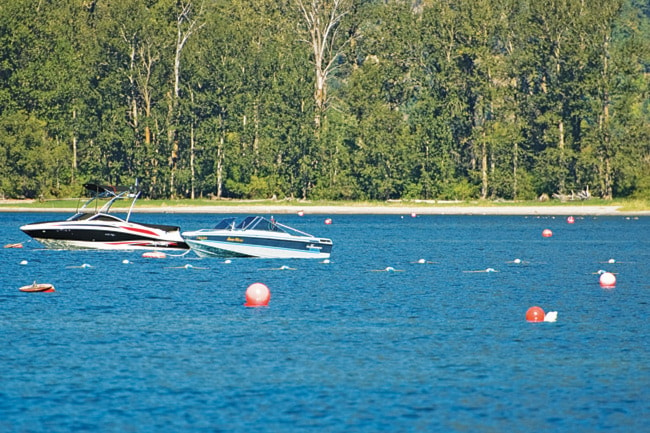The public hearings are done and now the proposed foreshore and water zoning bylaw goes to the Columbia Shuswap Regional District board for third reading.
CSRD planner Marcin Pachcinski told the crowds in Sicamous, Celista and Sorrento the proposed bylaw has been amended in response to the comments from earlier public consultations. Pachcinski said the portion of the bylaw concerning docks is more lenient than Department of Fisheries and Oceans regulations but it reflects the needs of Shuswap residents.
“The DFO requirement is 1.5 metres water depth underneath for all portions of the dock. The issue with that is the water fluctuation in the Shuswap. Public feedback told us it’s not a practical requirement so the CSRD bylaw will require 1.5 metres only at the lakeside end of the dock,” Pachcinski said.
He explained that won’t change DFO requirements, but the CSRD will only be enforcing their regulation.
“Even if we don’t mirror DFO regulations, we encourage property owners maintain as much water depth as possible under their docks, or place them completely on dry land during the fall and winter.”
About 50 people attended the Sicamous meeting held Aug. 23. Pachcinski says one of the concerns expressed at the meeting was that local governments on the lake, including the District of Sicamous, take a similar approach to foreshore/water zoning bylaw so that there is consistency, regardless of which jurisdiction you are in.
Mayor Malcolm MacLeod, who was in attendance, said the bylaw is a step in the right direction. Although he says he’s concerned the CSRD may be misleading anyone thinking the proposed regional district bylaw can override federal regulations and the Department of Fisheries and Oceans when it comes to the 1.5 metres.
“The CSRD bylaw has said at the end of the dock whereas DFO is saying the end closest to the shore – the bottom line is the DFO has the final say in that,” says MacLeod. “Their rule is the one that’s in effect. I don’t know why the CSRD has put that in there that way, it sort of gives false hope to people.”
As for buoys, MacLeod sees this as a growing problem in the area that needs to be addressed.
“The last couple of years, these buoys have just been put out all over the place and I think people realize something is going to happen so they’re getting their buoys put in the water - a lot of lakeshore owners really upset with this,” says MacLeod.
Under the proposed bylaw, existing private mooring buoys could be grandfathered in. The problem MacLeod sees is that buoys are being placed inappropriately, such as in front of foreshore residences and public boat launches.
“There was a gentleman that said he has lakeshore property and a wharf and somebody has put a buoy out in front of his wharf, and that’s just not right,” said MacLeod, adding buoys are currently Transport Canada’s jurisdiction, and their restriction is based on whether they pose a navigational hazard.
MacLeod suggested the District of Sicamous, instead of creating its own bylaw to deal with buoys, would instead participate in the CSRDs.
Pachcinski says the proliferation of buoys would be addressed in the bylaw as only waterfront and semi-waterfront land owners will be allowed to have buoys.
About 80 people attended the meeting in Celista on Saturday and, although there were some concerns, the Shuswap Water Action Team (SWAT) and Shuswap Waterfront Owners Association voiced support for the bylaw. SWAT’s membership, however, did offer a number of “enhancements” to the bylaw. Recommendations include setting a maximum moorage for large waterfront developments; basing the moorage for large developments on the length of the foreshore, similar to what is being proposed for residential; and a requirement for large foreshore developments to provide their own boat launch facility.
There were a lot of questions from the 150 people who showed up at the Sorrento meeting held on Tuesday with a few expressing worries how the bylaw would impact their existing docks. Others spoke in favour having local regulations.
Using 2008 data from the Shuswap Watershed Mapping Project, there are 2,789 docks on the three lakes combined and that means 6.86 docks for every kilometre of shoreline. There are 1,529 retaining walls which, in total, cover 13 per cent of the shoreline.
